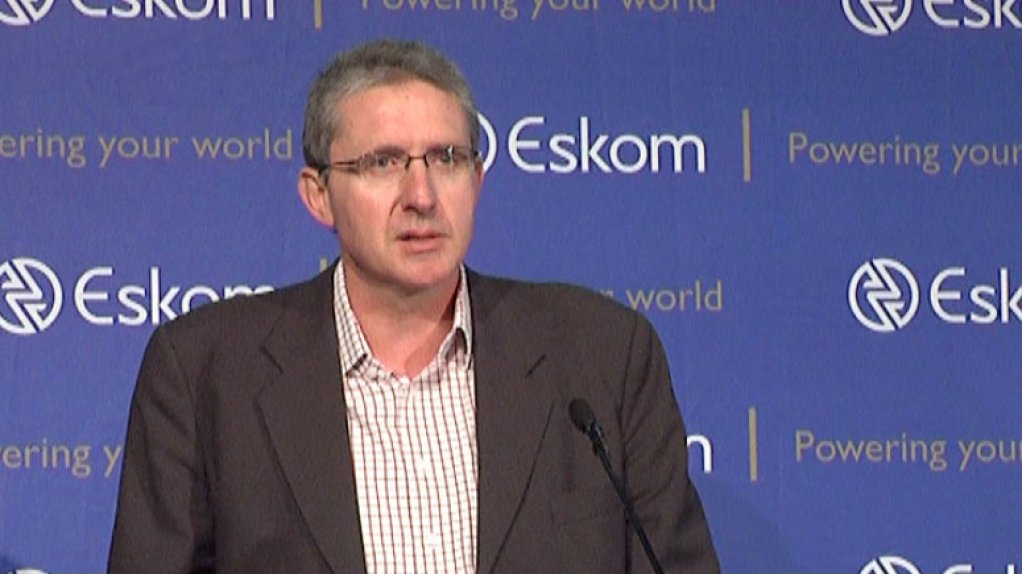Power utility Eskom has indicated that it plans to engage with the National Energy Regulator of South Africa (Nersa) on ways to claw back primary-energy costs that are rising well ahead of what has been allowed for in the tariff determination.
During the year ended March 31, 2013, Eskom’s primary energy costs surged by 36.1% to 28.05c/kWh, with coal accounting for 53% of the increase. Primary energy is the largest single component of the utility’s overall costs, which rose to 54.2c/kWh, from 41.3c/kWh in the previous year.
CEO Brian Dames says the fact that its tariff is regulated while coal prices are not presents a “fundamental problem” for Eskom, which it will seek to address systematically through the regulatory clearing account mechanism and possibly through reopening of tariff discussions with Nersa.
The group is in the throes of an organisational ‘re-engineering’ process that will seek to calibrate the business with the third multiyear price determination (MYPD3), which left it with a R225-billion financial gap to close – the difference between Eskom’s 16% a year tariff request and the 8% determination.
Besides drawing on the Nersa regulatory clearing account mechanism, consideration is being given to placing a freeze on new employment and seeking government approval for changes to its mandate.
However, of immediate concern is the likely near-term deviation between MYPD3 assumptions on coal costs and actual expenses.
Eskom requested, and received, yearly coal-related increases of 10% over the five-year period, from April 1, 2013 to March 31, 2018. However, the request was premised on the conclusion of a “compact” with coal miners designed to constrain cost increases over the period.
“We have met with the industry and have provided a draft compact and they are excited and supportive of [the idea],” Dames reports.
However, the compact has not yet been concluded, with a key feature being better delivery from Eskom’s cost-plus mines, so that the utility is less dependent on expensive short-term contracts.
“It is the fundamental problem of having a regulated tariff on the one hand and an input cost that is now 50% of overall costs. So, we have to engage with the regulator and we have started that process as to how we deal with it.”
But Eskom is also concerned about the longer-term outlook for coal supply, beyond 2018, which some are warning could evolve into a coal-supply 'cliff’ unless action is taken to develop new sources of supply for Eskom, which produces 85% of its power from coal.
South African Coal Roadmap chairperson Ian Hall has reported that there is an urgent need to create an environment conducive to new coal-mining investment.
Hall reports that no significant coal project to supply Eskom has been approved or funded for development since the coal roadmap process began more than two years ago.
Eskom head of primary energy Kiren Maharaj says that besides the compact with established miners, various initiatives are under way to improve security of supply post-2018, including the creation of a fund to support emerging coal miners.
An entity had been appointed to assist Eskom to establish the fund and ensure transparent governance mechanism around the allocation of funding.
Eskom has also interrogated possible imports from Botswana and Mozambique, but says such a strategy is constrained by Eskom’s demand for a certain quality of coal. Therefore, emphasis is also being given to beneficiating more domestic coal to ensure that it is available at the quality required by the power station fleet.
“At this point in time, one of our immediate options is the Waterberg. We intend to do full-scale testing around coal in that area,” Maharaj reports, adding that the focus is on dealing with the "bulk shortfall" from 2018.
Fellow State-owned utility Transnet, meanwhile, is working on a transport solution to unlock the Waterberg coal resources both for domestic use and for export through Richard Bay, in KwaZulu-Natal.
EMAIL THIS ARTICLE SAVE THIS ARTICLE
To subscribe email subscriptions@creamermedia.co.za or click here
To advertise email advertising@creamermedia.co.za or click here












